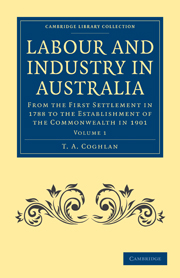 Labour and Industry in Australia
Labour and Industry in Australia Book contents
- Frontmatter
- PREFACE
- Contents
- PART I FROM THE FOUNDATION OF SETTLEMENT TO THE CROSSING OF THE MOUNTAINS
- I INTRODUCTION TO THE FIRST PERIOD
- II THE ASSIGNMENT SYSTEM
- III MUSTERS
- IV WAGES AND WORKING HOURS
- V THE CURRENCY
- VI LAND POLICY
- VII THE GENESIS OF THE WOOL INDUSTRY IN AUSTRALIA
- VIII THE INDUSTRIES OF THE PERIOD
- IX TRADE AND PRICES
- PART II FROM THE CROSSING OF THE MOUNTAINS TO THE ABOLITION OF THE ASSIGNMENT SYSTEM
- PART III FROM THE ABOLITION OF THE ASSIGNMENT SYSTEM TO THE DISCOVERY OF GOLD
- PART IV FROM THE DISCOVERY OF GOLD TO THE INTRODUCTION OF FREE SELECTION OF LAND BEFORE SURVEY
II - THE ASSIGNMENT SYSTEM
Published online by Cambridge University Press: 05 August 2011
- Frontmatter
- PREFACE
- Contents
- PART I FROM THE FOUNDATION OF SETTLEMENT TO THE CROSSING OF THE MOUNTAINS
- I INTRODUCTION TO THE FIRST PERIOD
- II THE ASSIGNMENT SYSTEM
- III MUSTERS
- IV WAGES AND WORKING HOURS
- V THE CURRENCY
- VI LAND POLICY
- VII THE GENESIS OF THE WOOL INDUSTRY IN AUSTRALIA
- VIII THE INDUSTRIES OF THE PERIOD
- IX TRADE AND PRICES
- PART II FROM THE CROSSING OF THE MOUNTAINS TO THE ABOLITION OF THE ASSIGNMENT SYSTEM
- PART III FROM THE ABOLITION OF THE ASSIGNMENT SYSTEM TO THE DISCOVERY OF GOLD
- PART IV FROM THE DISCOVERY OF GOLD TO THE INTRODUCTION OF FREE SELECTION OF LAND BEFORE SURVEY
Summary
It is at best very doubtful whether the organizers of the first expedition to Australia had any clear notion how they would be able to utilize the labour of the transportees in their new homes. It is not impossible they saw in imagination spacious farms called into being almost immediately, and harvests gathered therefrom in the first year of settlement. Otherwise it is difficult to understand how the inadequate supplies of food in the First Fleet were so poorly supplemented that within a few months of Phillip's arrival the colony was on the verge of starvation. The Governor's first inspection of the new territory made it obvious to him that many months must elapse before the soil could be got ready for the plough, and in the hilly and infertile land around Sydney large farms were impracticable. Hence the Governor found himself in the face of conditions against which no provision had been made, and saw that it would be necessary to disperse his population and permit the civil and military officers to occupy land and establish homes for themselves, while the severe work of pioneering was being undertaken. As there was no other labour obtainable—there being not a dozen free men outside the ranks of the soldiers, sailors, and civil officers—the Governor found it expedient to grant to those whose position admitted of the concession being made, the services of convicts to clear the ground, build houses, and do such other work, both mechanical and domestic, as might be required.
- Type
- Chapter
- Information
- Labour and Industry in AustraliaFrom the First Settlement in 1788 to the Establishment of the Commonwealth in 1901, pp. 24 - 39Publisher: Cambridge University PressPrint publication year: 2011First published in: 1918


